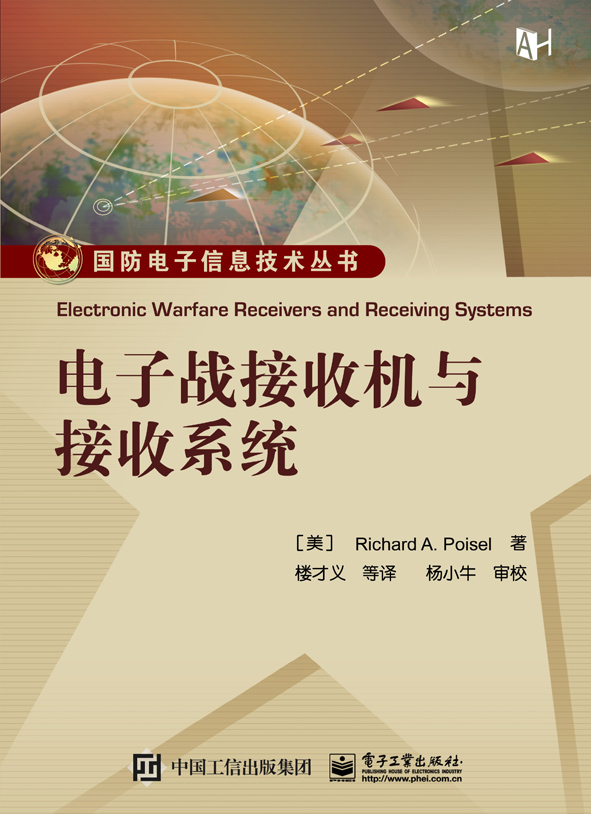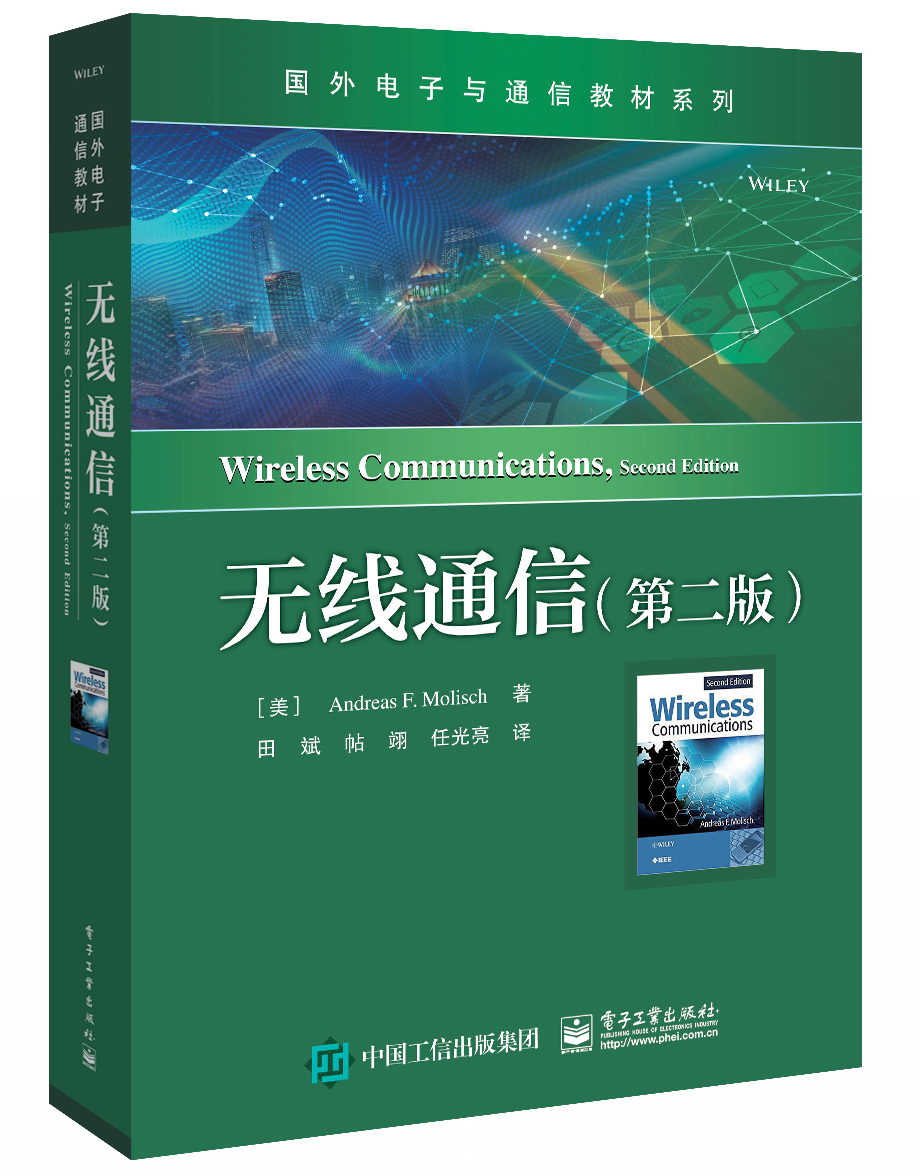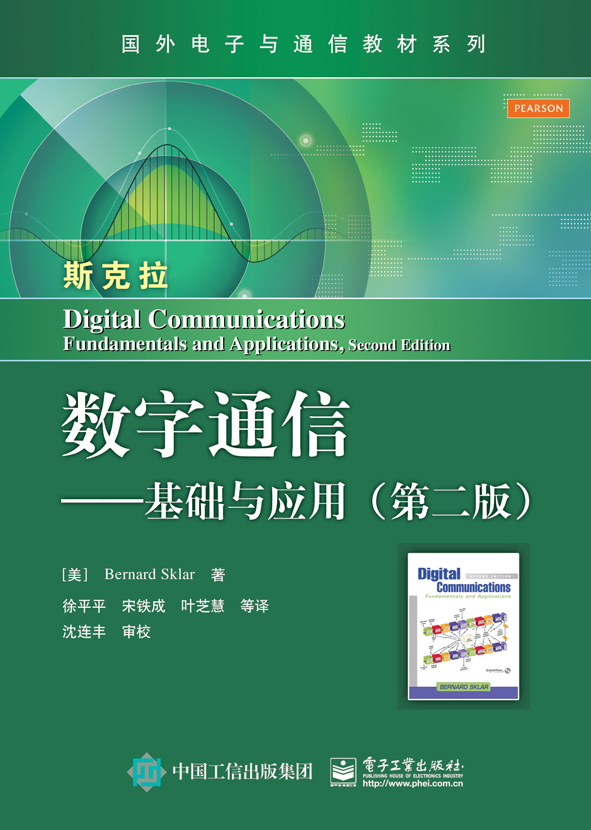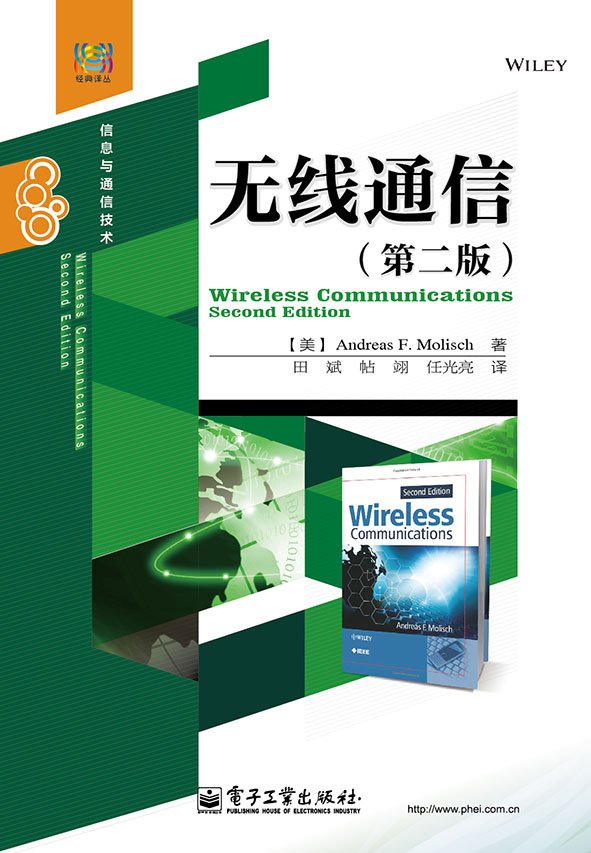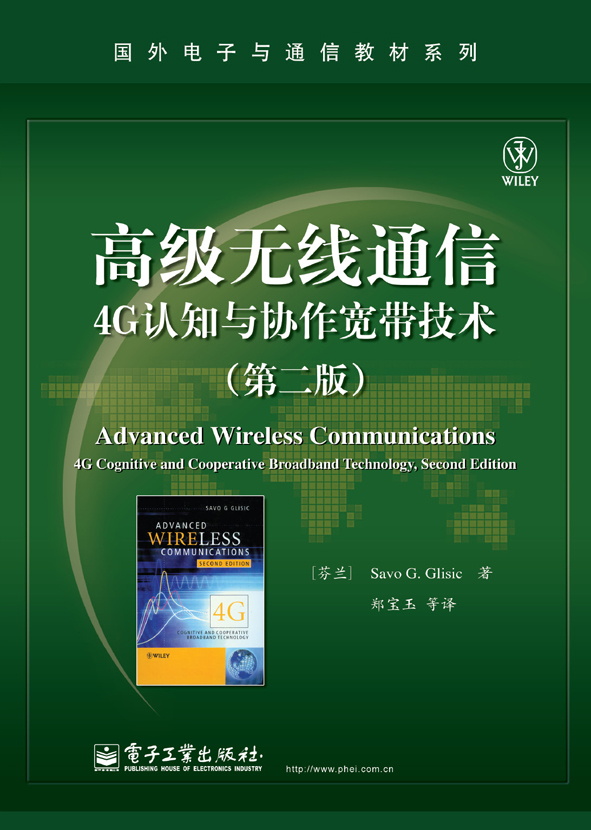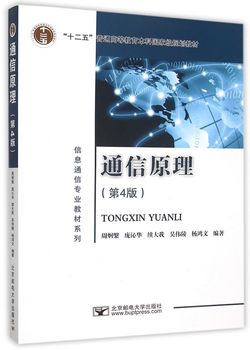- 电子工业出版社
- 9787121387128
- 1-1
- 349879
- 16开
- 2020-04
- 668
- 通信工程
- 本科 研究生(硕士、EMBA、MBA、MPA、博士)
内容简介
本书是无线通信领域的一本优秀的经典教材,介绍了无线通信的基本原理,重点论述了无线通信系统的基本理论与设计分析方法。全书内容包括无线信道模型、无线信道容量、无线通信中的调制编码技术及均衡处理技术、分集、扩频通信,还包括多天线系统、多用户系统、多载波调制、自适应调制与编码、蜂窝系统及无线自组织网络等。影印版制作时已根据配套网站提供的勘误表(2006年版)对内容进行了更正。
目录
1 Overview of Wireless Communications 无线通信概述
1.1 History of Wireless Communications 无线通信的历史
1.2 Wireless Vision 无线愿景
1.3 Technical Issues 技术问题
1.4 Current Wireless Systems 现有无线系统
1.4.1 Cellular Telephone Systems 蜂窝电话系统
1.4.2 Cordless Phones 无绳电话系统
1.4.3 Wireless Local Area Networks 无线局域网
1.4.4 Wide Area Wireless Data Services 广域无线数据业务
1.4.5 Broadband Wireless Access 宽带无线接入
1.4.6 Paging Systems 寻呼系统
1.4.7 Satellite Networks 卫星通信网
1.4.8 Low-Cost, Low-Power Radios: Bluetooth and ZigBee 低成本、低功率的无线通信:蓝牙和紫蜂
1.4.9 Ultrawideband Radios 超宽带无线通信
1.5 The Wireless Spectrum 无线频谱
1.5.1 Methods for Spectrum Allocation 频谱的分配方式
1.5.2 Spectrum Allocations for Existing Systems 现有系统的频谱分配
1.6 Standards 标准
Problems 习题
References 参考文献
2 Path Loss and Shadowing 路径损耗和阴影衰落
2.1 Radio Wave Propagation 无线电波传播
2.2 Transmit and Receive Signal Models 发送和接收信号模型
2.3 Free-Space Path Loss 自由空间路径损耗
2.4 Ray Tracing 射线跟踪
2.4.1 Two-Ray Model 两径模型
2.4.2 Ten-Ray Model (Dielectric Canyon) 十径模型(介电峡谷)
2.4.3 General Ray Tracing 通用射线跟踪
2.4.4 Local Mean Received Power 本地平均接收功率
2.5 Empirical Path-Loss Models 经验路径损耗模型
2.5.1 Okumura Model 奥村模型
2.5.2 Hata Model 哈塔模型
2.5.3 COST 231 Extension to Hata Model 哈塔模型的COST 231扩展
2.5.4 Piecewise Linear (Multislope) Model 折线(多斜率)模型
2.5.5 Indoor Attenuation Factors 室内衰减因子
2.6 Simplified Path-Loss Model 简化的路径损耗模型
2.7 Shadow Fading 阴影衰落
2.8 Combined Path Loss and Shadowing 路径损耗和阴影衰落的混合模型
2.9 Outage Probability under Path Loss and Shadowing 路径损耗和阴影衰落造成的中断率
2.10?Cell Coverage Area 小区覆盖范围
Problems 习题
References 参考文献
3 Statistical Multipath Channel Models 统计多径信道模型
3.1 Time-Varying Channel Impulse Response 时变信道的冲激响应
3.2 Narrowband Fading Models 窄带衰落模型
3.2.1 Autocorrelation, Cross-Correlation, and Power Spectral Density 自相关、互相关和功率谱密度
3.2.2 Envelope and Power Distributions 包络和功率分布
3.2.3 Level Crossing Rate and Average Fade Duration 电平通过率和平均衰落时长
3.2.4 Finite-State Markov Channels 有限状态马尔可夫信道
3.3 Wideband Fading Models 宽带衰落模型
3.3.1 Power Delay Profile 功率时延谱
3.3.2 Coherence Bandwidth 相干带宽
3.3.3 Doppler Power Spectrum and Channel Coherence Time 多普勒功率谱和信道相干时间
3.3.4 Transforms for Autocorrelation and Scattering Functions 自相关和散射函数的变换
3.4 Discrete-Time Model 离散时间模型
3.5 Space-Time Channel Models 空时信道模型
Problems 习题
References 参考文献
4 Capacity of Wireless Channels 无线信道的信道容量
4.1 Capacity in AWGN AWGN信道容量
4.2 Capacity of Flat Fading Channels 平坦衰落信道的容量
4.2.1 Channel and System Model 信道和系统模型
4.2.2 Channel Distribution Information Known 信道分布信息已知
4.2.3 Channel Side Information at Receiver 接收端已知CSI
4.2.4 Channel Side Information at Transmitter and Receiver 收发两端都已知CSI
4.2.5 Capacity with Receiver Diversity 接收分集的信道容量
4.2.6 Capacity Comparisons 容量对比
4.3 Capacity of Frequency-Selective Fading Channels 频率选择性衰落信道的容量
4.3.1 Time-Invariant Channels 时不变信道
4.3.2 Time-Varying Channels 时变信道
Problems 习题
References 参考文献
5 Digital Modulation and Detection 数字调制与检测
5.1 Signal Space Analysis 信号空间分析
5.1.1 Signal and System Model 信号与系统模型
5.1.2 Geometric Representation of Signals 信号的几何表示
5.1.3 Receiver Structure and Sufficient Statistics 接收机结构和充分统计量
5.1.4 Decision Regions and the Maximum Likelihood Decision Criterion 判决域和最大似然判决准则
5.1.5 Error Probability and the Union Bound 误码率和联合界
5.2 Passband Modulation Principles 带通调制原理
5.3 Amplitude and Phase Modulation 幅度/相位调制
5.3.1 Pulse Amplitude Modulation (MPAM) 脉冲幅度调制
5.3.2 Phase-Shift Keying (MPSK) 相移键控
5.3.3 Quadrature Amplitude Modulation (MQAM) 正交幅度调制
5.3.4 Differential Modulation 差分调制
5.3.5 Constellation Shaping 星座成形
5.3.6 Quadrature Offset 正交偏移
5.4 Frequency Modulation 频率调制
5.4.1 Frequency-Shift Keying (FSK) and Minimum-Shift Keying (MSK) 频移键控和最小频移键控
5.4.2 Continuous-Phase FSK (CPFSK) 连续相位频移键控
5.4.3 Noncoherent Detection of FSK FSK的非相干检测
5.5 Pulse Shaping 脉冲成形
5.6 Symbol Synchronization and Carrier Phase Recovery 码元同步和载波相位恢复
5.6.1 Receiver Structure with Phase and Timing Recovery 具有相位和定时恢复的接收机结构
5.6.2 Maximum Likelihood Phase Estimation 最大似然相位估计
5.6.3 Maximum Likelihood Timing Estimation 最大似然定时估计
Problems 习题
References 参考文献
6 Performance of Digital Modulation over Wireless Channels 无线信道中数字调制的性能
6.1 AWGN Channels AWGN信道
6.1.1 Signal-to-Noise Power Ratio and Bit /Symbol Energy 信噪比和比特/符号能量
6.1.2 Error Probability for BPSK and QPSK BPSK和QPSK的差错概率
6.1.3 Error Probability for MPSK MPSK的差错概率
6.1.4 Error Probability for MPAM and MQAM MPAM和MQAM的差错概率
6.1.5 Error Probability for FSK and CPFSK FSK和CPFSK的差错概率
6.1.6 Error Probability Approximation for Coherent Modulations 相干调制的差错概率的近似
6.1.7 Error Probability for Differential Modulation 差分调制的差错概率
6.2 Alternate Q-Function Representation Q函数的一种等效表示法
6.3 Fading 衰落信道
6.3.1 Outage Probability 中断率
6.3.2 Average Probability of Error 平均差错概率
6.3.3 Moment Generating Function Approach to Average Error Probability 用矩母函数求平均差错概率
6.3.4 Combined Outage and Average Error Probability 中断率和平均差错概率的结合
6.4 Doppler Spread 多普勒频移
6.5 Intersymbol Interference 码间干扰
Problems 习题
References 参考文献
7 Diversity 分集
7.1 Realization of Independent Fading Paths 独立衰落路径的实现
7.2 Receiver Diversity 接收分集
7.2.1 System Model 系统模型
7.2.2 Selection Combining 选择合并
7.2.3 Threshold Combining 阈值合并
7.2.4 Maximal-Ratio Combining 最大比合并
7.2.5 Equal-Gain Combining 等增益合并
7.3 Transmitter Diversity 发送分集
7.3.1 Channel Known at Transmitter 发送端已知信道
7.3.2 Channel Unknown at Transmitter – The Alamouti Scheme 发送端未知信道(Alamouti方案)
7.4 Moment Generating Functions in Diversity Analysis 利用矩母函数分析分集
7.4.1 Diversity Analysis for MRC MRC分集的分析
7.4.2 Diversity Analysis for EGC and SC EGC和SC分集的分析
7.4.3 Diversity Analysis for Noncoherent and Differentially Coherent Modulation 非相干和差分相干调制时分集系统的性能分析
Problems 习题
References 参考文献
8 Coding for Wireless Channels 无线信道中的编码
8.1 Overview of Code Design 码设计概述
8.2 Linear Block Codes 线性分组码
8.2.1 Binary Linear Block Codes 二进制线性分组码
8.2.2 Generator Matrix 生成矩阵
8.2.3 Parity-Check Matrix and Syndrome Testing 校验矩阵与伴随式
8.2.4 Cyclic Codes 循环码
8.2.5 Hard Decision Decoding (HDD) 硬判决译码
8.2.6 Probability of Error for HDD in AWGN AWGN信道中硬判决译码的差错概率
8.2.7 Probability of Error for SDD in AWGN AWGN信道中软判决译码的差错概率
8.2.8 Common Linear Block Codes 常见的线性分组码
8.2.9 Nonbinary Block Codes: The Reed Solomon Code 多进制分组码:Reed Solomon码
8.3 Convolutional Codes 卷积码
8.3.1 Code Characterization: Trellis Diagrams 编码特性:网格图
8.3.2 Maximum Likelihood Decoding 最大似然译码
8.3.3 The Viterbi Algorithm 维特比算法
8.3.4 Distance Properties 距离特性
8.3.5 State Diagrams and Transfer Functions?状态图和转移函数
8.3.6 Error Probability for Convolutional Codes 卷积码的误码率
8.4 Concatenated Codes 级联码
8.5 Turbo Codes Turbo码
8.6 Low-Density Parity-Check Codes 低密度校验码
8.7 Coded Modulation 编码调制
8.8 Coding with Interleaving for Fading Channels 衰落信道下的交织编码
8.8.1 Block Coding with Interleaving 分组码的交织
8.8.2 Convolutional Coding with Interleaving 卷积码的交织
8.8.3 Coded Modulation with Symbol/ Bit Interleaving 符号/比特交织的编码调制
8.9 Unequal Error Protection Codes 不等差错保护码
8.10?Joint Source and Channel Coding 信源信道联合编码
Problems 习题
References 参考文献
9 Adaptive Modulation and Coding 自适应调制与编码
9.1 Adaptive Transmission System 自适应传输系统
9.2 Adaptive Techniques 自适应技术
9.2.1 Variable-Rate Techniques 速率控制技术
9.2.2 Variable-Power Techniques 功率控制技术
9.2.3 Variable Error Probability 误码率控制技术
9.2.4 Variable-Coding Techniques 编码控制技术
9.2.5 Hybrid Techniques 混合技术
9.3 Variable-Rate Variable-Power MQAM 速率可变、功率可变的MQAM
9.3.1 Error Probability Bounds 误码率界
9.3.2 Adaptive Rate and Power Schemes 自适应速率及功率模式
9.3.3 Channel Inversion with Fixed Rate 固定速率的信道反转
9.3.4 Discrete-Rate Adaptation 离散速率的自适应
9.3.5 Average Fade Region Duration 衰落区的平均持续时间
9.3.6 Exact versus Approximate Bit Error Probability 误比特率的精确值和近似值的对比
9.3.7 Channel Estimation Error and Delay 信道估计误差和估计时延的影响
9.3.8 Adaptive Coded Modulation 自适应编码调制
9.4 General M-ary Modulations 一般的M进制调制
9.4.1 Continuous-Rate Adaptation 连续速率的自适应
9.4.2 Discrete-Rate Adaptation 离散速率的自适应
9.4.3 Average BER Target 平均BER目标
9.5 Adaptive Techniques in Combined Fast and Slow Fading 结合快衰落和慢衰落的自适应技术
Problems 习题
References 参考文献
10 Multiple Antennas and Space-Time Communications 多天线和空时通信
10.1 Narrowband MIMO Model 窄带MIMO模型
10.2 Parallel Decomposition of the MIMO Channel MIMO信道的并行分解
10.3 MIMO Channel Capacity MIMO信道的容量
10.3.1 Static Channels 静态信道
10.3.2 Fading Channels 衰落信道
10.4 MIMO Diversity Gain: Beamforming MIMO分集增益:波束成形
10.5 Diversity-Multiplexing Trade-offs 分集和复用的折中
10.6 Space-Time Modulation and Coding 空时调制与编码
10.6.1 ML Detection and Pairwise Error Probability 最大似然检测和成对差错概率
10.6.2 Rank and Determinant Criteria 秩和行列式准则
10.6.3 Space-Time Trellis and Block Codes 空时格码和空时分组码
10.6.4 Spatial Multiplexing and BLAST Architectures 空分复用和BLAST结构
10.7 Frequency-Selective MIMO Channels 频率选择性MIMO信道
10.8 Smart Antennas 智能天线
Problems 习题
References 参考文献
11 Equalization 均衡
11.1 Equalizer Noise Enhancement 均衡器中的噪声增强
11.2 Equalizer Types 均衡器的类型
11.3 Folded Spectrum and ISI-Free Transmission 折叠谱和无ISI传输
11.4 Linear Equalizers 线性均衡
11.4.1 Zero-Forcing (ZF) Equalizers 迫零均衡
11.4.2 Minimum Mean-Square Error (MMSE) Equalizers 最小均方误差均衡
11.5 Maximum Likelihood Sequence Estimation 最大似然序列估计
11.6 Decision-Feedback Equalization 判决反馈均衡
11.7 Other Equalization Methods 其他均衡方法
11.8 Adaptive Equalizers: Training and Tracking 自适应均衡:训练和跟踪
Problems 习题
References 参考文献
12 Multicarrier Modulation 载波调制
12.1 Data Transmission Using Multiple Carriers 多载波数据传输
12.2 Multicarrier Modulation with Overlapping Subchannels 重叠子信道的多载波调制
12.3 Mitigation of Subcarrier Fading 子载波衰落的抑制
12.3.1 Coding with Interleaving over Time and Frequency 时频域交织编码
12.3.2 Frequency Equalization 频域均衡
12.3.3 Precoding 预编码
12.3.4 Adaptive Loading 自适应加载
12.4 Discrete Implementation of Multicarrier Modulation 离散多载波调制的实现
12.4.1 The DFT and Its Properties DFT及其性质
12.4.2 The Cyclic Prefix 循环前缀
12.4.3 Orthogonal Frequency-Division Multiplexing (OFDM) 正交频分复用
12.4.4 Matrix Representation of OFDM OFDM的矩阵表示
12.4.5 Vector Coding 向量编码
12.5 Challenges in Multicarrier Systems 多载波系统中的挑战
12.5.1 Peak-to-Average Power Ratio 峰均比
12.5.2 Frequency and Timing Offset 频率偏移和时间偏移
12.6 Case Study: The IEEE 802.11a Wireless LAN Standard 案例研究:IEEE 802.11a无线局域网标准
Problems 习题
References 参考文献
13 Spread Spectrum 扩频
13.1 Spread-Spectrum Principles 扩频原理
13.2 Direct-Sequence Spread Spectrum (DSSS) 直接序列扩频
13.2.1 DSSS System Model DSSS系统模型
13.2.2 Spreading Codes for ISI Rejection: Random, Pseudorandom, and m-Sequences 抑制ISI的扩频码:随机码、伪随机码和m序列
13.2.3 Synchronization 同步
13.2.4 RAKE Receivers RAKE接收机
13.3 Frequency-Hopping Spread Spectrum (FHSS) 跳频扩频系统
13.4 Multiuser DSSS Systems 多用户DSSS系统
13.4.1 Spreading Codes for Multiuser DSSS 多用户DSSS系统中的扩频码
13.4.2 Downlink Channels 下行信道
13.4.3 Uplink Channels 上行信道
13.4.4 Multiuser Detection 多用户检测
13.4.5 Multicarrier CDMA 多载波CDMA
13.5 Multiuser FHSS Systems 多用户FHSS系统
Problems 习题
References 参考文献
14 Multiuser Systems 多用户系统
14.1 Multiuser Channels: The Uplink and Downlink 多用户信道:上行与下行
14.2 Multiple Access 多址接入
14.2.1 Frequency-Division Multiple Access (FDMA) 频分多址接入
14.2.2 Time-Division Multiple Access (TDMA) 时分多址接入
14.2.3 Code-Division Multiple Access (CDMA) 码分多址接入
14.2.4 Space-Division Multiple Access (SDMA) 空分多址接入
14.2.5 Hybrid Techniques 混合多址接入
14.3 Random Access 随机接入
14.3.1 Pure ALOHA 纯ALOHA
14.3.2 Slotted ALOHA 时隙ALOHA
14.3.3 Carrier-Sense Multiple Access (CSMA) 载波监听多址接入
14.3.4 Scheduling 调度
14.4 Power Control 功率控制
14.5 Downlink (Broadcast) Channel Capacity 下行(广播)信道容量
14.5.1 Channel Model 信道模型
14.5.2 Capacity in AWGN AWGN信道容量
14.5.3 Common Data 公共数据
14.5.4 Capacity in Fading 衰落信道容量
14.5.5 Capacity with Multiple Antennas 多天线容量
14.6 Uplink (Multiple Access) Channel Capacity 上行(多址)信道容量
14.6.1 Capacity in AWGN AWGN信道容量
14.6.2 Capacity in Fading 衰落信道容量
14.6.3 Capacity with Multiple Antennas 多天线容量
14.7 Uplink–Downlink Duality 上下行信道的对偶性
14.8 Multiuser Diversity 多用户分集
14.9 MIMO Multiuser Systems MIMO多用户系统
Problems 习题
References 参考文献
15 Cellular Systems and Infrastructure-Based Wireless Networks 蜂窝系统和架构式无线网络
15.1 Cellular System Fundamentals 蜂窝系统的基本概念
15.2 Channel Reuse 信道复用
15.3 SIR and User Capacity SIR和用户容量
15.3.1 Orthogonal Systems (TDMA/FDMA) 正交系统(TDMA/FDMA)
15.3.2 Nonorthogonal Systems (CDMA) 非正交系统 (CDMA)
15.4 Interference Reduction Techniques 抗干扰技术
15.5 Dynamic Resource Allocation 动态资源分配
15.5.1 Scheduling 调度
15.5.2 Dynamic Channel Assignment 动态信道分配
15.5.3 Power Control 功率控制
15.6 Fundamental Rate Limits 基本速率极限
15.6.1 Shannon Capacity of Cellular Systems 蜂窝系统的香农容量
15.6.2 Area Spectral Efficiency 面积频谱效率
Problems 习题
References 参考文献
16 Ad Hoc Wireless Networks 无线自组织网络
16.1 Applications 应用
16.1.1 Data Networks 数据网络
16.1.2 Home Networks 家庭网络
16.1.3 Device Networks 设备网络
16.1.4 Sensor Networks 传感器网络
16.1.5 Distributed Control Systems 分布式控制系统
16.2 Design Principles and Challenges 设计原则和挑战
16.3 Protocol Layers 协议层
16.3.1 Physical Layer Design 物理层设计
16.3.2 Access Layer Design 接入层设计
16.3.3 Network Layer Design 网络层设计
16.3.4 Transport Layer Design 传输层设计
16.3.5 Application Layer Design 应用层设计
16.4 Cross-Layer Design 跨层设计
16.5 Network Capacity Limits 网络的容量极限
16.6 Energy-Constrained Networks 能量受限网络
16.6.1 Modulation and Coding 调制和编码
16.6.2 MIMO and Cooperative MIMO MIMO及合作MIMO
16.6.3 Access, Routing, and Sleeping 接入、路由和休眠
16.6.4 Cross-Layer Design under Energy Constraints 能量约束下的跨层设计
16.6.5 Capacity per Unit Energy 单位能量的容量
Problems 习题
References 参考文献
Appendix A Representation of Bandpass Signals and Channels 带通信号和信道的表示
Appendix B Probability Theory, Random Variables, and Random Processes 概率论、随机变量和随机过程
Appendix C Matrix Definitions, Operations, and Properties 矩阵的定义、运算和性质
Appendix D Summary of Wireless Standards 无线标准摘要
Bibliography 参考书目
Index 索引
1.1 History of Wireless Communications 无线通信的历史
1.2 Wireless Vision 无线愿景
1.3 Technical Issues 技术问题
1.4 Current Wireless Systems 现有无线系统
1.4.1 Cellular Telephone Systems 蜂窝电话系统
1.4.2 Cordless Phones 无绳电话系统
1.4.3 Wireless Local Area Networks 无线局域网
1.4.4 Wide Area Wireless Data Services 广域无线数据业务
1.4.5 Broadband Wireless Access 宽带无线接入
1.4.6 Paging Systems 寻呼系统
1.4.7 Satellite Networks 卫星通信网
1.4.8 Low-Cost, Low-Power Radios: Bluetooth and ZigBee 低成本、低功率的无线通信:蓝牙和紫蜂
1.4.9 Ultrawideband Radios 超宽带无线通信
1.5 The Wireless Spectrum 无线频谱
1.5.1 Methods for Spectrum Allocation 频谱的分配方式
1.5.2 Spectrum Allocations for Existing Systems 现有系统的频谱分配
1.6 Standards 标准
Problems 习题
References 参考文献
2 Path Loss and Shadowing 路径损耗和阴影衰落
2.1 Radio Wave Propagation 无线电波传播
2.2 Transmit and Receive Signal Models 发送和接收信号模型
2.3 Free-Space Path Loss 自由空间路径损耗
2.4 Ray Tracing 射线跟踪
2.4.1 Two-Ray Model 两径模型
2.4.2 Ten-Ray Model (Dielectric Canyon) 十径模型(介电峡谷)
2.4.3 General Ray Tracing 通用射线跟踪
2.4.4 Local Mean Received Power 本地平均接收功率
2.5 Empirical Path-Loss Models 经验路径损耗模型
2.5.1 Okumura Model 奥村模型
2.5.2 Hata Model 哈塔模型
2.5.3 COST 231 Extension to Hata Model 哈塔模型的COST 231扩展
2.5.4 Piecewise Linear (Multislope) Model 折线(多斜率)模型
2.5.5 Indoor Attenuation Factors 室内衰减因子
2.6 Simplified Path-Loss Model 简化的路径损耗模型
2.7 Shadow Fading 阴影衰落
2.8 Combined Path Loss and Shadowing 路径损耗和阴影衰落的混合模型
2.9 Outage Probability under Path Loss and Shadowing 路径损耗和阴影衰落造成的中断率
2.10?Cell Coverage Area 小区覆盖范围
Problems 习题
References 参考文献
3 Statistical Multipath Channel Models 统计多径信道模型
3.1 Time-Varying Channel Impulse Response 时变信道的冲激响应
3.2 Narrowband Fading Models 窄带衰落模型
3.2.1 Autocorrelation, Cross-Correlation, and Power Spectral Density 自相关、互相关和功率谱密度
3.2.2 Envelope and Power Distributions 包络和功率分布
3.2.3 Level Crossing Rate and Average Fade Duration 电平通过率和平均衰落时长
3.2.4 Finite-State Markov Channels 有限状态马尔可夫信道
3.3 Wideband Fading Models 宽带衰落模型
3.3.1 Power Delay Profile 功率时延谱
3.3.2 Coherence Bandwidth 相干带宽
3.3.3 Doppler Power Spectrum and Channel Coherence Time 多普勒功率谱和信道相干时间
3.3.4 Transforms for Autocorrelation and Scattering Functions 自相关和散射函数的变换
3.4 Discrete-Time Model 离散时间模型
3.5 Space-Time Channel Models 空时信道模型
Problems 习题
References 参考文献
4 Capacity of Wireless Channels 无线信道的信道容量
4.1 Capacity in AWGN AWGN信道容量
4.2 Capacity of Flat Fading Channels 平坦衰落信道的容量
4.2.1 Channel and System Model 信道和系统模型
4.2.2 Channel Distribution Information Known 信道分布信息已知
4.2.3 Channel Side Information at Receiver 接收端已知CSI
4.2.4 Channel Side Information at Transmitter and Receiver 收发两端都已知CSI
4.2.5 Capacity with Receiver Diversity 接收分集的信道容量
4.2.6 Capacity Comparisons 容量对比
4.3 Capacity of Frequency-Selective Fading Channels 频率选择性衰落信道的容量
4.3.1 Time-Invariant Channels 时不变信道
4.3.2 Time-Varying Channels 时变信道
Problems 习题
References 参考文献
5 Digital Modulation and Detection 数字调制与检测
5.1 Signal Space Analysis 信号空间分析
5.1.1 Signal and System Model 信号与系统模型
5.1.2 Geometric Representation of Signals 信号的几何表示
5.1.3 Receiver Structure and Sufficient Statistics 接收机结构和充分统计量
5.1.4 Decision Regions and the Maximum Likelihood Decision Criterion 判决域和最大似然判决准则
5.1.5 Error Probability and the Union Bound 误码率和联合界
5.2 Passband Modulation Principles 带通调制原理
5.3 Amplitude and Phase Modulation 幅度/相位调制
5.3.1 Pulse Amplitude Modulation (MPAM) 脉冲幅度调制
5.3.2 Phase-Shift Keying (MPSK) 相移键控
5.3.3 Quadrature Amplitude Modulation (MQAM) 正交幅度调制
5.3.4 Differential Modulation 差分调制
5.3.5 Constellation Shaping 星座成形
5.3.6 Quadrature Offset 正交偏移
5.4 Frequency Modulation 频率调制
5.4.1 Frequency-Shift Keying (FSK) and Minimum-Shift Keying (MSK) 频移键控和最小频移键控
5.4.2 Continuous-Phase FSK (CPFSK) 连续相位频移键控
5.4.3 Noncoherent Detection of FSK FSK的非相干检测
5.5 Pulse Shaping 脉冲成形
5.6 Symbol Synchronization and Carrier Phase Recovery 码元同步和载波相位恢复
5.6.1 Receiver Structure with Phase and Timing Recovery 具有相位和定时恢复的接收机结构
5.6.2 Maximum Likelihood Phase Estimation 最大似然相位估计
5.6.3 Maximum Likelihood Timing Estimation 最大似然定时估计
Problems 习题
References 参考文献
6 Performance of Digital Modulation over Wireless Channels 无线信道中数字调制的性能
6.1 AWGN Channels AWGN信道
6.1.1 Signal-to-Noise Power Ratio and Bit /Symbol Energy 信噪比和比特/符号能量
6.1.2 Error Probability for BPSK and QPSK BPSK和QPSK的差错概率
6.1.3 Error Probability for MPSK MPSK的差错概率
6.1.4 Error Probability for MPAM and MQAM MPAM和MQAM的差错概率
6.1.5 Error Probability for FSK and CPFSK FSK和CPFSK的差错概率
6.1.6 Error Probability Approximation for Coherent Modulations 相干调制的差错概率的近似
6.1.7 Error Probability for Differential Modulation 差分调制的差错概率
6.2 Alternate Q-Function Representation Q函数的一种等效表示法
6.3 Fading 衰落信道
6.3.1 Outage Probability 中断率
6.3.2 Average Probability of Error 平均差错概率
6.3.3 Moment Generating Function Approach to Average Error Probability 用矩母函数求平均差错概率
6.3.4 Combined Outage and Average Error Probability 中断率和平均差错概率的结合
6.4 Doppler Spread 多普勒频移
6.5 Intersymbol Interference 码间干扰
Problems 习题
References 参考文献
7 Diversity 分集
7.1 Realization of Independent Fading Paths 独立衰落路径的实现
7.2 Receiver Diversity 接收分集
7.2.1 System Model 系统模型
7.2.2 Selection Combining 选择合并
7.2.3 Threshold Combining 阈值合并
7.2.4 Maximal-Ratio Combining 最大比合并
7.2.5 Equal-Gain Combining 等增益合并
7.3 Transmitter Diversity 发送分集
7.3.1 Channel Known at Transmitter 发送端已知信道
7.3.2 Channel Unknown at Transmitter – The Alamouti Scheme 发送端未知信道(Alamouti方案)
7.4 Moment Generating Functions in Diversity Analysis 利用矩母函数分析分集
7.4.1 Diversity Analysis for MRC MRC分集的分析
7.4.2 Diversity Analysis for EGC and SC EGC和SC分集的分析
7.4.3 Diversity Analysis for Noncoherent and Differentially Coherent Modulation 非相干和差分相干调制时分集系统的性能分析
Problems 习题
References 参考文献
8 Coding for Wireless Channels 无线信道中的编码
8.1 Overview of Code Design 码设计概述
8.2 Linear Block Codes 线性分组码
8.2.1 Binary Linear Block Codes 二进制线性分组码
8.2.2 Generator Matrix 生成矩阵
8.2.3 Parity-Check Matrix and Syndrome Testing 校验矩阵与伴随式
8.2.4 Cyclic Codes 循环码
8.2.5 Hard Decision Decoding (HDD) 硬判决译码
8.2.6 Probability of Error for HDD in AWGN AWGN信道中硬判决译码的差错概率
8.2.7 Probability of Error for SDD in AWGN AWGN信道中软判决译码的差错概率
8.2.8 Common Linear Block Codes 常见的线性分组码
8.2.9 Nonbinary Block Codes: The Reed Solomon Code 多进制分组码:Reed Solomon码
8.3 Convolutional Codes 卷积码
8.3.1 Code Characterization: Trellis Diagrams 编码特性:网格图
8.3.2 Maximum Likelihood Decoding 最大似然译码
8.3.3 The Viterbi Algorithm 维特比算法
8.3.4 Distance Properties 距离特性
8.3.5 State Diagrams and Transfer Functions?状态图和转移函数
8.3.6 Error Probability for Convolutional Codes 卷积码的误码率
8.4 Concatenated Codes 级联码
8.5 Turbo Codes Turbo码
8.6 Low-Density Parity-Check Codes 低密度校验码
8.7 Coded Modulation 编码调制
8.8 Coding with Interleaving for Fading Channels 衰落信道下的交织编码
8.8.1 Block Coding with Interleaving 分组码的交织
8.8.2 Convolutional Coding with Interleaving 卷积码的交织
8.8.3 Coded Modulation with Symbol/ Bit Interleaving 符号/比特交织的编码调制
8.9 Unequal Error Protection Codes 不等差错保护码
8.10?Joint Source and Channel Coding 信源信道联合编码
Problems 习题
References 参考文献
9 Adaptive Modulation and Coding 自适应调制与编码
9.1 Adaptive Transmission System 自适应传输系统
9.2 Adaptive Techniques 自适应技术
9.2.1 Variable-Rate Techniques 速率控制技术
9.2.2 Variable-Power Techniques 功率控制技术
9.2.3 Variable Error Probability 误码率控制技术
9.2.4 Variable-Coding Techniques 编码控制技术
9.2.5 Hybrid Techniques 混合技术
9.3 Variable-Rate Variable-Power MQAM 速率可变、功率可变的MQAM
9.3.1 Error Probability Bounds 误码率界
9.3.2 Adaptive Rate and Power Schemes 自适应速率及功率模式
9.3.3 Channel Inversion with Fixed Rate 固定速率的信道反转
9.3.4 Discrete-Rate Adaptation 离散速率的自适应
9.3.5 Average Fade Region Duration 衰落区的平均持续时间
9.3.6 Exact versus Approximate Bit Error Probability 误比特率的精确值和近似值的对比
9.3.7 Channel Estimation Error and Delay 信道估计误差和估计时延的影响
9.3.8 Adaptive Coded Modulation 自适应编码调制
9.4 General M-ary Modulations 一般的M进制调制
9.4.1 Continuous-Rate Adaptation 连续速率的自适应
9.4.2 Discrete-Rate Adaptation 离散速率的自适应
9.4.3 Average BER Target 平均BER目标
9.5 Adaptive Techniques in Combined Fast and Slow Fading 结合快衰落和慢衰落的自适应技术
Problems 习题
References 参考文献
10 Multiple Antennas and Space-Time Communications 多天线和空时通信
10.1 Narrowband MIMO Model 窄带MIMO模型
10.2 Parallel Decomposition of the MIMO Channel MIMO信道的并行分解
10.3 MIMO Channel Capacity MIMO信道的容量
10.3.1 Static Channels 静态信道
10.3.2 Fading Channels 衰落信道
10.4 MIMO Diversity Gain: Beamforming MIMO分集增益:波束成形
10.5 Diversity-Multiplexing Trade-offs 分集和复用的折中
10.6 Space-Time Modulation and Coding 空时调制与编码
10.6.1 ML Detection and Pairwise Error Probability 最大似然检测和成对差错概率
10.6.2 Rank and Determinant Criteria 秩和行列式准则
10.6.3 Space-Time Trellis and Block Codes 空时格码和空时分组码
10.6.4 Spatial Multiplexing and BLAST Architectures 空分复用和BLAST结构
10.7 Frequency-Selective MIMO Channels 频率选择性MIMO信道
10.8 Smart Antennas 智能天线
Problems 习题
References 参考文献
11 Equalization 均衡
11.1 Equalizer Noise Enhancement 均衡器中的噪声增强
11.2 Equalizer Types 均衡器的类型
11.3 Folded Spectrum and ISI-Free Transmission 折叠谱和无ISI传输
11.4 Linear Equalizers 线性均衡
11.4.1 Zero-Forcing (ZF) Equalizers 迫零均衡
11.4.2 Minimum Mean-Square Error (MMSE) Equalizers 最小均方误差均衡
11.5 Maximum Likelihood Sequence Estimation 最大似然序列估计
11.6 Decision-Feedback Equalization 判决反馈均衡
11.7 Other Equalization Methods 其他均衡方法
11.8 Adaptive Equalizers: Training and Tracking 自适应均衡:训练和跟踪
Problems 习题
References 参考文献
12 Multicarrier Modulation 载波调制
12.1 Data Transmission Using Multiple Carriers 多载波数据传输
12.2 Multicarrier Modulation with Overlapping Subchannels 重叠子信道的多载波调制
12.3 Mitigation of Subcarrier Fading 子载波衰落的抑制
12.3.1 Coding with Interleaving over Time and Frequency 时频域交织编码
12.3.2 Frequency Equalization 频域均衡
12.3.3 Precoding 预编码
12.3.4 Adaptive Loading 自适应加载
12.4 Discrete Implementation of Multicarrier Modulation 离散多载波调制的实现
12.4.1 The DFT and Its Properties DFT及其性质
12.4.2 The Cyclic Prefix 循环前缀
12.4.3 Orthogonal Frequency-Division Multiplexing (OFDM) 正交频分复用
12.4.4 Matrix Representation of OFDM OFDM的矩阵表示
12.4.5 Vector Coding 向量编码
12.5 Challenges in Multicarrier Systems 多载波系统中的挑战
12.5.1 Peak-to-Average Power Ratio 峰均比
12.5.2 Frequency and Timing Offset 频率偏移和时间偏移
12.6 Case Study: The IEEE 802.11a Wireless LAN Standard 案例研究:IEEE 802.11a无线局域网标准
Problems 习题
References 参考文献
13 Spread Spectrum 扩频
13.1 Spread-Spectrum Principles 扩频原理
13.2 Direct-Sequence Spread Spectrum (DSSS) 直接序列扩频
13.2.1 DSSS System Model DSSS系统模型
13.2.2 Spreading Codes for ISI Rejection: Random, Pseudorandom, and m-Sequences 抑制ISI的扩频码:随机码、伪随机码和m序列
13.2.3 Synchronization 同步
13.2.4 RAKE Receivers RAKE接收机
13.3 Frequency-Hopping Spread Spectrum (FHSS) 跳频扩频系统
13.4 Multiuser DSSS Systems 多用户DSSS系统
13.4.1 Spreading Codes for Multiuser DSSS 多用户DSSS系统中的扩频码
13.4.2 Downlink Channels 下行信道
13.4.3 Uplink Channels 上行信道
13.4.4 Multiuser Detection 多用户检测
13.4.5 Multicarrier CDMA 多载波CDMA
13.5 Multiuser FHSS Systems 多用户FHSS系统
Problems 习题
References 参考文献
14 Multiuser Systems 多用户系统
14.1 Multiuser Channels: The Uplink and Downlink 多用户信道:上行与下行
14.2 Multiple Access 多址接入
14.2.1 Frequency-Division Multiple Access (FDMA) 频分多址接入
14.2.2 Time-Division Multiple Access (TDMA) 时分多址接入
14.2.3 Code-Division Multiple Access (CDMA) 码分多址接入
14.2.4 Space-Division Multiple Access (SDMA) 空分多址接入
14.2.5 Hybrid Techniques 混合多址接入
14.3 Random Access 随机接入
14.3.1 Pure ALOHA 纯ALOHA
14.3.2 Slotted ALOHA 时隙ALOHA
14.3.3 Carrier-Sense Multiple Access (CSMA) 载波监听多址接入
14.3.4 Scheduling 调度
14.4 Power Control 功率控制
14.5 Downlink (Broadcast) Channel Capacity 下行(广播)信道容量
14.5.1 Channel Model 信道模型
14.5.2 Capacity in AWGN AWGN信道容量
14.5.3 Common Data 公共数据
14.5.4 Capacity in Fading 衰落信道容量
14.5.5 Capacity with Multiple Antennas 多天线容量
14.6 Uplink (Multiple Access) Channel Capacity 上行(多址)信道容量
14.6.1 Capacity in AWGN AWGN信道容量
14.6.2 Capacity in Fading 衰落信道容量
14.6.3 Capacity with Multiple Antennas 多天线容量
14.7 Uplink–Downlink Duality 上下行信道的对偶性
14.8 Multiuser Diversity 多用户分集
14.9 MIMO Multiuser Systems MIMO多用户系统
Problems 习题
References 参考文献
15 Cellular Systems and Infrastructure-Based Wireless Networks 蜂窝系统和架构式无线网络
15.1 Cellular System Fundamentals 蜂窝系统的基本概念
15.2 Channel Reuse 信道复用
15.3 SIR and User Capacity SIR和用户容量
15.3.1 Orthogonal Systems (TDMA/FDMA) 正交系统(TDMA/FDMA)
15.3.2 Nonorthogonal Systems (CDMA) 非正交系统 (CDMA)
15.4 Interference Reduction Techniques 抗干扰技术
15.5 Dynamic Resource Allocation 动态资源分配
15.5.1 Scheduling 调度
15.5.2 Dynamic Channel Assignment 动态信道分配
15.5.3 Power Control 功率控制
15.6 Fundamental Rate Limits 基本速率极限
15.6.1 Shannon Capacity of Cellular Systems 蜂窝系统的香农容量
15.6.2 Area Spectral Efficiency 面积频谱效率
Problems 习题
References 参考文献
16 Ad Hoc Wireless Networks 无线自组织网络
16.1 Applications 应用
16.1.1 Data Networks 数据网络
16.1.2 Home Networks 家庭网络
16.1.3 Device Networks 设备网络
16.1.4 Sensor Networks 传感器网络
16.1.5 Distributed Control Systems 分布式控制系统
16.2 Design Principles and Challenges 设计原则和挑战
16.3 Protocol Layers 协议层
16.3.1 Physical Layer Design 物理层设计
16.3.2 Access Layer Design 接入层设计
16.3.3 Network Layer Design 网络层设计
16.3.4 Transport Layer Design 传输层设计
16.3.5 Application Layer Design 应用层设计
16.4 Cross-Layer Design 跨层设计
16.5 Network Capacity Limits 网络的容量极限
16.6 Energy-Constrained Networks 能量受限网络
16.6.1 Modulation and Coding 调制和编码
16.6.2 MIMO and Cooperative MIMO MIMO及合作MIMO
16.6.3 Access, Routing, and Sleeping 接入、路由和休眠
16.6.4 Cross-Layer Design under Energy Constraints 能量约束下的跨层设计
16.6.5 Capacity per Unit Energy 单位能量的容量
Problems 习题
References 参考文献
Appendix A Representation of Bandpass Signals and Channels 带通信号和信道的表示
Appendix B Probability Theory, Random Variables, and Random Processes 概率论、随机变量和随机过程
Appendix C Matrix Definitions, Operations, and Properties 矩阵的定义、运算和性质
Appendix D Summary of Wireless Standards 无线标准摘要
Bibliography 参考书目
Index 索引


